Earth is a celestial body that is in constant motion within the universe. It undergoes rotation on its axis and travels millions of kilometers in its orbit around the Sun. Along with the entire planetary system, it slowly orbits around the center of the Milky Way galaxy. The Earth’s rotation and orbit around the Sun are easily observable to its inhabitants through changes in daily and seasonal lighting, temperature fluctuations, and the unique characteristics of each season. Today, we will focus on the specific characteristics and duration of the Earth’s revolution around the Sun, as well as its impact on the planet’s life.
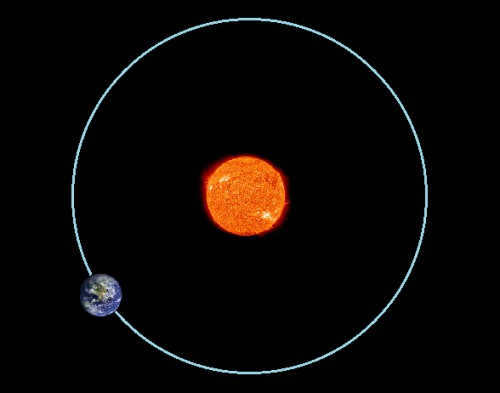
Key Details
The Earth revolves around the Sun in the third farthest orbit. The average distance between the Sun and our planet is about 149.5 million kilometers. The total length of the orbit is approximately 940 million kilometers. It takes the Earth 365 days and 6 hours to complete one orbit around the Sun. This period is known as a sideral year. The Earth’s average speed during its orbit is about 30 km/s.
From the perspective of an observer on Earth, the planet’s orbit can be seen as the Sun’s movement across the sky. The Sun appears to move about one degree per day in the eastern direction relative to the stars.
The path of planet Earth
The trajectory of our planet is not a perfect circle. It is actually an elliptical path with the Sun located at one of its foci. This unique shape of the orbit causes the Earth to approach the Sun and then move away from it. The point at which the distance from the planet to the Sun is at its minimum is known as perihelion. On the other hand, aphelion is the part of the orbit where the Earth is at its maximum distance from the Sun. In our current time, the Earth reaches perihelion around January 3, and aphelion around July 4. Additionally, the Earth does not move around the Sun at a constant speed: it accelerates and decelerates after passing aphelion, once it has surpassed perihelion.
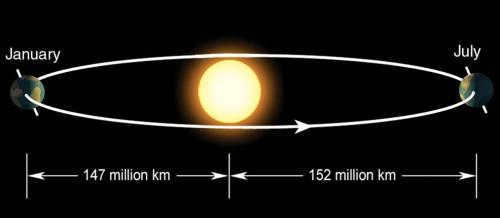
The minimum distance separating the two celestial bodies in January is 147 million kilometers, while the maximum distance is 152 million kilometers.
Sputnik
Together with Earth, the Moon orbits around the Sun. When observed from the North Pole, the satellite moves in a counterclockwise direction. The Earth’s orbit and the Moon’s orbit are situated in different planes, with an angle of approximately 5 degrees between them. This misalignment significantly reduces the occurrence of lunar and solar eclipses. If the orbital planes were aligned, one of these phenomena would happen every two weeks.
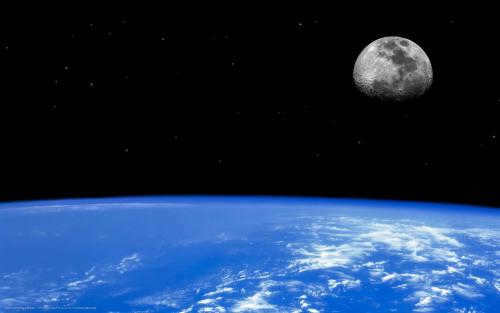
The Earth and the Moon have orbits that are organized in a manner that causes both objects to rotate around a shared center of mass every 27.3 days. As a result, the Moon’s tidal forces gradually decelerate the Earth’s rotation on its axis, leading to a slight increase in the length of each day.
Implications
The orientation of Earth’s axis in relation to its orbital plane has significant consequences on climate patterns. Throughout the year, the tilt of the planet’s axis and its movement around the sun result in distinct changes in weather conditions. When the North Pole is tilted towards the sun, the sun appears higher in the sky over our region. This leads to longer days and higher temperatures. Conversely, when the North Pole is tilted away from the sun, temperatures cool down. Similar climate variations occur in the Southern Hemisphere.
The transition between seasons occurs during the equinoxes and solstices, which mark specific positions of Earth’s axis in relation to its orbit. Let’s explore these events in more detail.
The day with the most daylight and the day with the least daylight
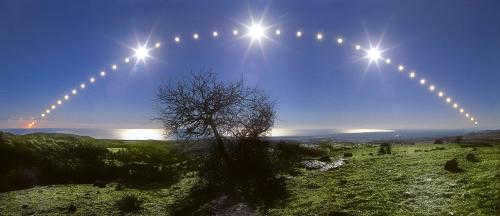
The solstice is the moment when the Earth’s axis is tilted to the maximum extent towards or away from the Sun. The Earth’s orbit around the Sun has two sections where this occurs. In regions with middle latitudes, the Sun appears to rise higher and higher in the sky every day until the summer solstice, which happens on June 21 in the northern hemisphere (the longest day of the year). After the summer solstice, the Sun’s position at noon begins to decrease until December 21-22, which marks the winter solstice. During the winter solstice, the northern hemisphere experiences its shortest day, and then the days start getting longer again. In the southern hemisphere, the tilt of the Earth’s axis is opposite, so the winter solstice falls in June and the summer solstice in December.
The equinox marks the moment when the planet’s axis aligns perpendicularly with the plane of its orbit. During this time, the terminator, which separates the illuminated and dark portions, passes directly through the poles, resulting in equal durations of day and night. There are two equinox points along the planet’s orbit. The vernal equinox occurs on March 20th, while the autumnal equinox occurs on September 23rd. These dates apply to the northern hemisphere. In the southern hemisphere, similar to the solstices, the equinoxes swap positions: March represents the autumn equinox, while September represents the spring equinox.
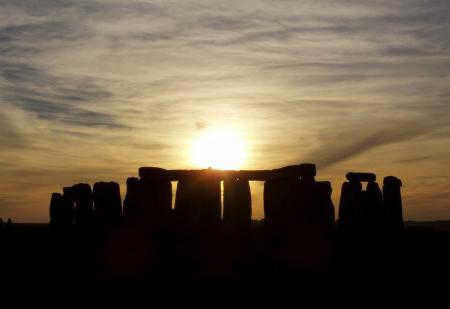
Which hemisphere is warmer?
The circular orbit of the Earth, along with its axial tilt, has an interesting effect. When the planet is at its closest point to the Sun, the south pole is directly facing it. This results in summer in the southern hemisphere. During this time, the Earth receives 6.9% more energy compared to when it is at its farthest point from the Sun (aphelion). The southern hemisphere benefits from this additional energy, receiving slightly more solar heat throughout the year compared to the northern hemisphere. However, it’s worth noting that this difference is relatively small, as a significant portion of the extra energy is absorbed by the waters of the southern hemisphere.
Tropical and Sideric Year
The duration of the Earth’s orbit around the Sun in relation to the stars is approximately 365 days, 6 hours, and 9 minutes, as previously mentioned. This is known as the sideric year. It can be assumed that the change of seasons also occurs within this timeframe. However, this assumption is not entirely accurate: the Earth’s orbit around the Sun does not align perfectly with the complete cycle of seasons. Instead, it corresponds to the tropical year, which lasts for 365 days, 5 hours, and 51 minutes. This measurement is often taken from one vernal equinox to the next. The slight twenty-minute discrepancy between the two durations is due to the precession of the Earth’s axis.
Yearly Calendar
For the sake of convenience, it is generally accepted that a year consists of 365 days. The additional six and a fraction of hours are accumulated over the course of four Earth orbits around the Sun. In order to account for this and prevent the discrepancy between the calendar year and the sideric year from growing, an “additional” day, February 29th, is included.


The moon, the Earth’s only satellite, has an impact on this phenomenon. As previously mentioned, it causes a deceleration in the Earth’s rotation, resulting in a lengthening of the day by approximately one thousandth every hundred years.
The concept of counting days was first introduced in 1582. The Gregorian calendar, which differs from the Julian calendar, ensures that the “civil” year aligns with the complete cycle of seasonal changes. Under this calendar system, the months, days of the week, and dates repeat exactly every four hundred years. In terms of duration, the Gregorian calendar closely approximates the tropical calendar.
The goal of the reform was to restore the vernal equinox to its original position on March 21st. Historically, the date of equal day and night had shifted to March 10th from the 1st century A.D. to the 16th century. The primary reason for revising the calendar was the necessity of accurately determining the date of Easter. To achieve this, it was crucial to ensure that March 21st remained as close as possible to the actual equinox. The Gregorian calendar successfully accomplishes this objective. A change in the vernal equinox date by one day will not occur until at least 10,000 years in the future.

In the event of a comparison between the calendar and tropical year, there is a possibility for more significant alterations. Due to the idiosyncrasies of Earth’s movement and the influencing factors, a discrepancy of one day in the change of seasons will accumulate over approximately 3200 years. If it is crucial to maintain a rough equality between the tropical and calendar year during that time, a reform similar to the one implemented in the 16th century will once again be necessary.
The duration of the Earth’s revolution around the Sun corresponds to various concepts of time, including the calendar, sideric year, and tropical year. Over time, methods for measuring these durations have been improved and refined. Recent findings about celestial interactions provide insights into the future understanding of the term “year” in thousands of years from now. The Earth’s revolution around the Sun, its relationship with the changing seasons, and its impact on the calendar serve as a prime example of how astronomical processes shape human society and the interconnectedness of elements within the vast Universe.
Are you familiar with the term “orbit” in relation to planets? In our Geography class (grade 6), we learned about the structure of the solar system, but many of us may not have fully understood what an orbit is, its purpose, and what would happen if a planet were to change its orbit.
Understanding the concept of an orbit
So, what exactly is an orbit? To put it simply, an orbit is the path that a celestial body takes around the Sun. Due to the force of gravity, a cosmic body follows this same path year after year, for millions of years. On average, planets have an elliptical orbit. The closer the orbit is to a perfect circle, the more stable the weather conditions on the planet will be.
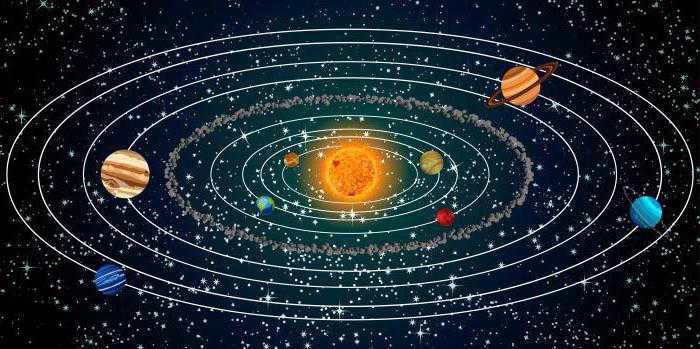
The key elements of an orbit include the period of revolution and the radius. The average radius is determined by calculating the mean value between the minimum and maximum diameters of the orbit. The period of revolution refers to the time it takes for a celestial object to complete a full rotation around a star. It is worth noting that the greater the distance between the star and the planet, the longer the period of revolution will be. This is because the gravitational pull of the star is weaker towards the outer edges of the system compared to its center.
Due to the absence of perfectly circular orbits, a planet is at different distances from its star throughout its orbital period. The point in the planet’s orbit where it is closest to the star is referred to as periastre, while the point farthest from the star is known as apoastre. In the case of our solar system, these points are called perihelion and aphelion, respectively.
Components of the Orbit
The meaning of the term “orbit” is apparent when discussing planets. However, what exactly do the elements of an orbit signify? The orbit is typically characterized by several elements. These parameters are crucial in determining the orbit type, the planet’s motion characteristics, and other less significant factors that may not concern the general public.
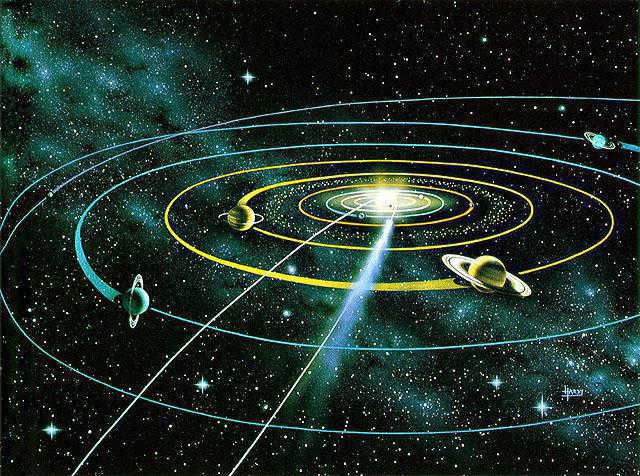
- Eccentricity is a measure used to determine the elongation of a planet’s orbit. A lower eccentricity indicates a more circular orbit, while a higher eccentricity means that the celestial body moves in a highly elongated ellipse around its star. The planets in our solar system have very low eccentricities, suggesting that their orbits are nearly circular. On the other hand, comets are known for their unusually high eccentricities.
- The major semi-axis is a value calculated from the planet to a point that is halfway along its orbit. It should not be confused with apastron, as the star is not located at the center of the orbit but at one of its foci.
The paths of the planets in the solar system
The trajectories of the celestial bodies in the solar system
The courses of the heavenly bodies in the solar system
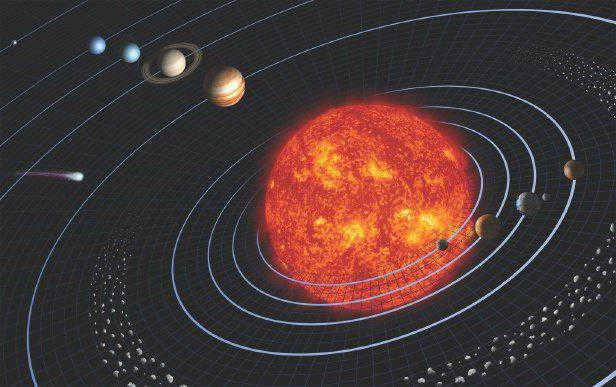
Therefore, the planetary orbit refers to the path that a planet follows around a star. In our solar system, all the planets orbit the Sun in the same direction. This motion can be explained by the theory of the Universe’s origin: after the Big Bang, the primordial matter moved in a specific direction, and over time it became more compact. Although the matter became denser over time, its direction of motion remained unchanged.
The planets also rotate on their own axes, similar to the Sun’s rotation. However, there are two exceptions to this pattern: Venus and Uranus. These two planets have unique rotation modes, possibly influenced by celestial bodies that altered their axis of rotation.
Plane of motion in the solar system
The orbits of the planets in the solar system are nearly aligned with the plane of Earth’s orbit. It is believed that this alignment is due to the historical formation of the solar system. The matter that makes up the planets and other celestial bodies was once a single cloud, spinning on its axis under the influence of gravity. As time passed, this cloud separated into two parts: one became the Sun, while the other formed a disk of dust that orbited the Sun. This dust gradually coalesced to form the planets, and their rotation direction has remained the same.
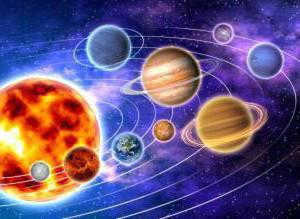
Planetary Orbits
Gaining an understanding of this concept can be quite challenging. The truth is, we have a grasp on what defines the orbit of a planet, but until recently, the existence of planets in other star systems remained unknown. It is only in recent times, with the aid of cutting-edge technology and advanced observation techniques, that scientists have been able to determine the presence of exoplanets – planets located outside our solar system. Despite the tremendous capabilities of modern equipment, only a select few exoplanets have been captured on film or visually observed, leading to astonishment among the scientific community.

It is a reality that these few planets appear to be completely unfamiliar with the concept of a planet’s orbit. Geography affirms that all celestial bodies move in accordance with timeless principles, including the laws of motion. However, other stars do not seem to adhere to the laws of our solar system. There exist planets that are in close proximity to the star, which scientists previously believed could only exist on the outermost fringes of the system. Astonishingly, these planets deviate from the expected behavior dictated by calculations: they orbit in the opposite direction and their orbital planes are distinct, with elongated orbits.
Sudden Halting of a Planet
Indeed, an abrupt cessation of the Earth’s rotation, unrelated to any external force, is highly implausible. However, let us hypothetically consider such an event.
Despite the cessation of the planet’s rotation, its individual components would not come to an immediate halt. This implies that the magma and core would continue their inertial movement. Prior to the entire planet reaching a complete standstill, the Earth’s interior would have already completed several rotations, resulting in the complete fragmentation of the planet’s crust. Consequently, an instantaneous release of massive amounts of magma, accompanied by the formation of enormous fractures and unexpected volcanic eruptions, would occur. Consequently, life on Earth would cease to exist in a blink of an eye.
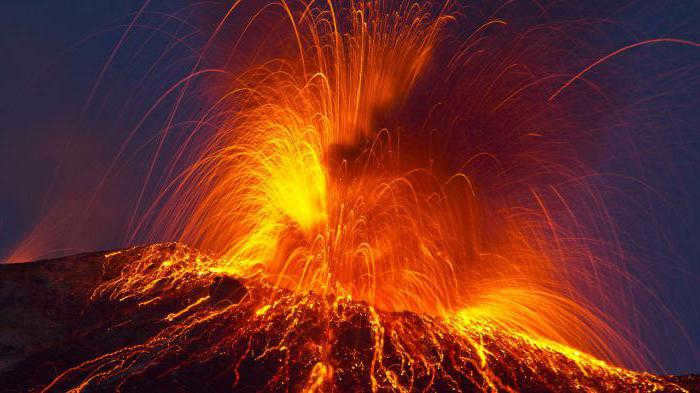
Furthermore, while it may be feasible to abruptly halt the process of “stuffing,” there remains the presence of the atmosphere, which will persist in its inertial motion. This motion occurs at a velocity of approximately 500 m/s.
This sort of “breeze” will sweep away all entities, living or inanimate, from the surface, transporting them alongside the atmosphere into the vast expanse of Space.
Gradual cessation of rotation
In the event that the gradual cessation of rotation around its axis occurs, rather than an abrupt stop, there would be a minimal chance of survival. As a consequence of this occurrence, the oceans would surge towards the poles, while the landmasses would be located at the equator. In such a scenario, a single day would be equivalent to an entire year, and the transition of seasons would also correspond to the progression of time throughout the day: morning would signify spring, day would represent summer, and so on. The temperature patterns would become significantly more extreme, as neither the oceans nor the movement of the atmosphere would temper them.
What if the Earth were to leave its orbit?
Let’s imagine a hypothetical scenario: what would occur if the Earth were to stray from its orbit? Normally, a planet cannot simply change its orbit without external intervention. Therefore, it would require a collision with another celestial body to cause such a significant disruption. In this scenario, the resulting explosion would unleash an immense force that would devastate everything and everyone.
If we hypothesize that the Earth has come to a halt in space, ceasing its orbit around the Sun, then the following sequence of events will unfold. Due to the Sun’s gravitational force, our planet will be pulled towards it. However, it will be unable to catch up to the Sun, as the Sun itself is not stationary. Nevertheless, it will come close enough to the Sun for the solar wind to obliterate the atmosphere, evaporate all the moisture, and incinerate the entire landmass. The desolate, scorched remains will continue to drift. As the Earth traverses the paths of remote planets, it will exert an influence on their orbits. When it nears the colossal gas giants, it is highly probable that the Earth will be fragmented into smaller fragments.

These are the possible situations that could occur if the Earth were to come to a halt. However, when asked if the planet could leave its orbit, scientists have a clear answer: no. The Earth has been orbiting the sun for over 4.5 billion years, and there is no foreseeable event that could disrupt this stability.
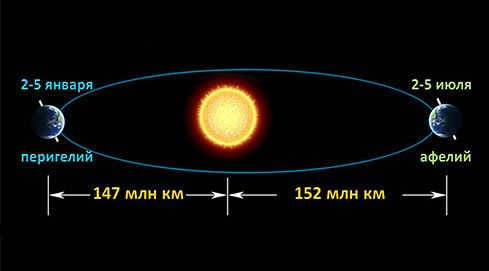

The Earth’s path around the Sun is known as its orbit. The shape of this orbit is an ellipse, and it is situated at an average distance of 150 million kilometers from the Sun (reaching a maximum distance known as aphelion at 152 million km, and a minimum distance known as perihelion at 147 million km).
In completing a full revolution around the Sun, covering a distance of 940 million kilometers, the Earth travels from west to east at an average speed of 108,000 km/h. This journey takes 365 days, 6 hours, 9 minutes, and 9 seconds, which is equivalent to one stellar year.
The Earth’s movement in its orbit around the Sun, as well as the tilt of its axis of rotation in relation to the plane of celestial movement, directly impact the changing of seasons and the variation in daylight hours.
Characteristics of the Earth’s orbit around the Sun
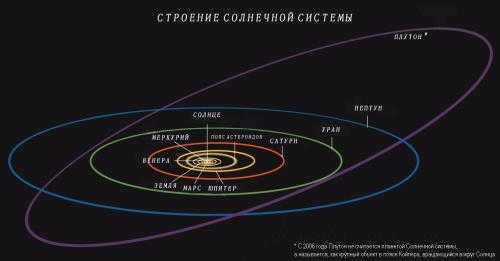
(The arrangement of the solar system)
In ancient times, astronomers held the belief that the Earth occupies the central position in the universe and that all other celestial bodies orbit around it. This theory, known as geocentrism, was later refuted by the Polish astronomer Nicolaus Copernicus in 1534. Copernicus introduced the heliocentric model, which demonstrated that the Sun does not revolve around the Earth, regardless of the desires of Ptolemy, Aristotle, and their adherents.
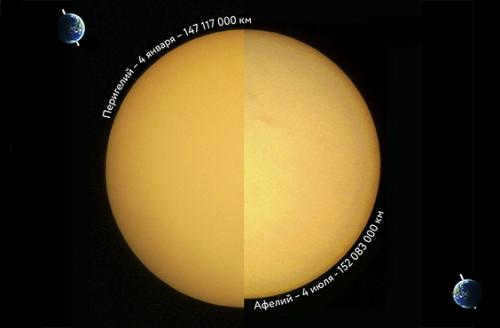
When moving along a specific path, the Earth’s distance from the Sun can reach its maximum point (known as aphelion or apogelion) on July 3, reaching 152 million kilometers, or it can reach its minimum point (known as perihelion) on January 3, reaching 147 million kilometers. However, it is important to note that these changes in distance are not the cause of seasonal changes, as commonly mistaken.
The transformation of seasons
As a result of the Earth’s axis being tilted at an angle of 66.5° to the plane of its orbit around the Sun, the distribution of heat and light on the Earth’s surface becomes uneven, leading to the alteration of seasons and the variation in the length of day and night.
Important point:
- The Earth’s rotation axis is tilted at an angle of 23.44° from the ecliptic axis (tilt of the Earth’s rotation axis)
- The Earth’s axis is tilted at an angle of 66.56° to the plane of its orbit around the Sun (determines the climatic changes of the seasons throughout the year)
An orbit is the trajectory that a celestial body follows in space. This term can refer to the path of any object, but it is commonly used to describe the path of motion for bodies that interact with each other. Examples of orbits include the paths of planets, satellites, and stars within systems.
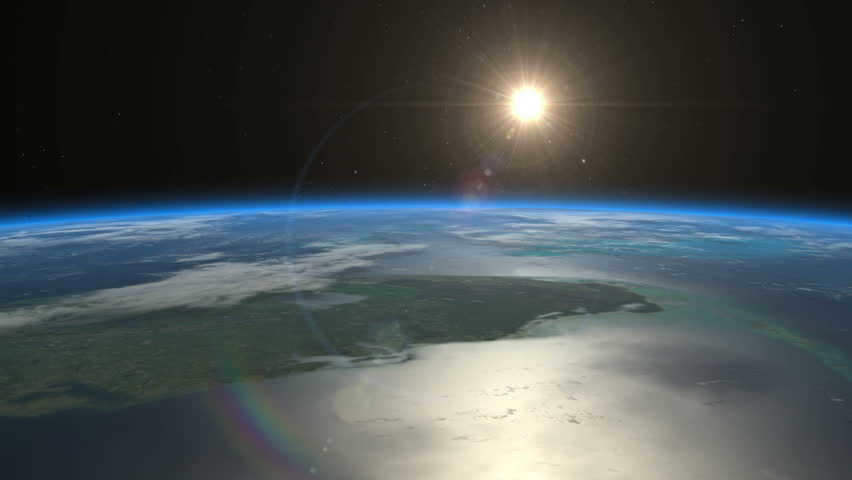

Categories of orbits
Orbits can be classified into two types: relative orbits and absolute orbits.
Absolute orbits are the trajectories followed by celestial bodies in a fixed reference framework that is universally recognized. The Universe as a whole serves as an example of such a reference framework.
What sets absolute and relative orbits apart?
Understanding the distinction between absolute and relative orbits is crucial when it comes to calculating trajectories based on Newton’s laws. While absolute orbits are primarily used for these calculations, we are more familiar with observing relative motion.
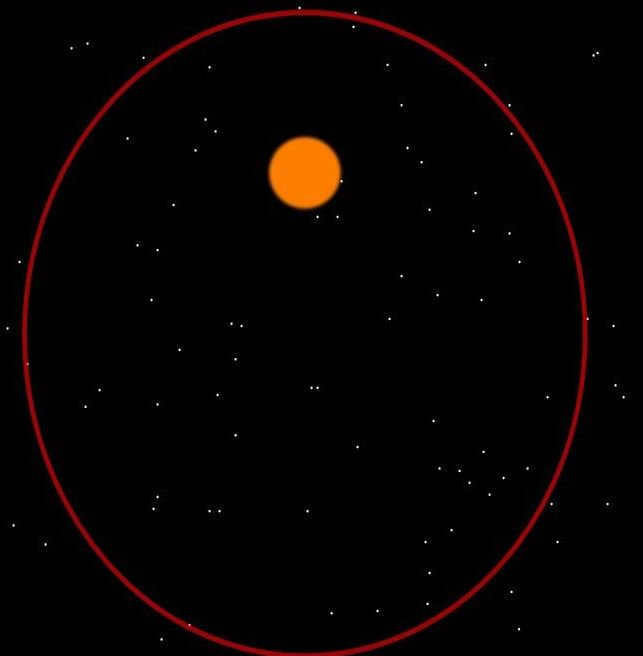
Solar Movement
The Sun’s journey through the vast expanse of space follows the same path as the Earth’s orbit. As the Earth travels along its orbit, it creates a colossal circle known as the ecliptic. This intersection of the cosmic sphere and the Earth’s orbital plane occurs at a specific angle, which determines the locations of the vernal and autumnal equinoxes. These equinoxes mark the points where the Sun crosses the celestial equator. Twice a year, the Sun passes through these points – once when it moves from the northern hemisphere to the southern hemisphere, and again when it returns to the northern hemisphere.
The Path of Earth’s Orbit
Earth follows an elliptical orbit around the Sun, with the Sun located at one of the foci. Throughout the year, the distance between Earth and the Sun varies, ranging from 147 million kilometers to 152 million kilometers. The total length of Earth’s orbit is approximately 930 million kilometers. Our planet travels in a westerly to easterly direction at a speed of approximately 30 kilometers per second. It completes one full orbit in 365 days, 6 hours, 9 minutes, and 9 seconds, which is known as a sidereal year.
Additionally, there is the concept of a tropical year, which refers to the time it takes for the Sun to complete certain consecutive movements through the vernal equinox point. This time interval is approximately 365 days, 5 hours, 48 minutes, and 46 seconds.
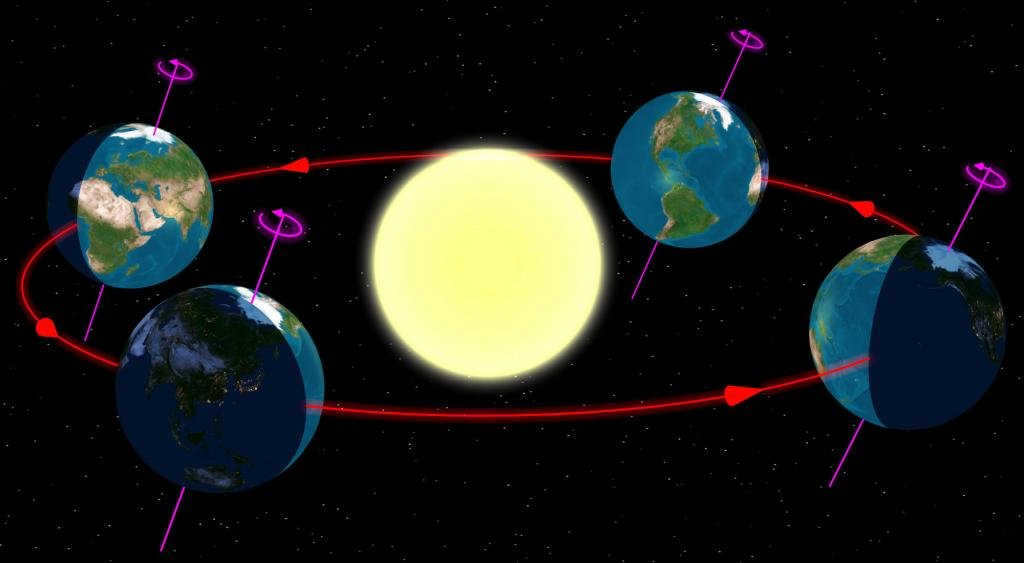
Calendar
The Gregorian calendar is used by people to measure time, taking into account the length of the tropical year with a slight variation. As a result, even in the next fifty thousand years, winter will still occur during the winter months and summer will occur during the summer months.
At present, the Earth’s axis is tilted at an angle of 66.5 degrees to the plane of its orbit. The planet moves around the sun in a parallel manner over the course of 365 days in the vast expanse of space. This movement of the Earth around the sun leads to the changing of seasons and the varying lengths of day and night.
Because of the Earth’s axial tilt in relation to its orbital plane, the planet’s position in outer space remains constant. This also impacts the varying angles at which the sun’s rays hit the Earth’s surface.
During the summer solstice, the planet’s axis is tilted towards the north, facing our star. Conversely, during the winter solstice, it is tilted towards the Sun in the southern hemisphere.
Elliptical orbit
Considering the length of the day and night as well as the positions of the Sun at various points, scientists have deduced that our planet does not travel in a perfect circle, but rather in an elliptical orbit. This concept was initially explained by Kepler, who also determined that both Mars and Earth experience periodic acceleration and deceleration. Through careful observation and calculation, he concluded that the planet’s movement follows an elliptical path rather than a circular one.
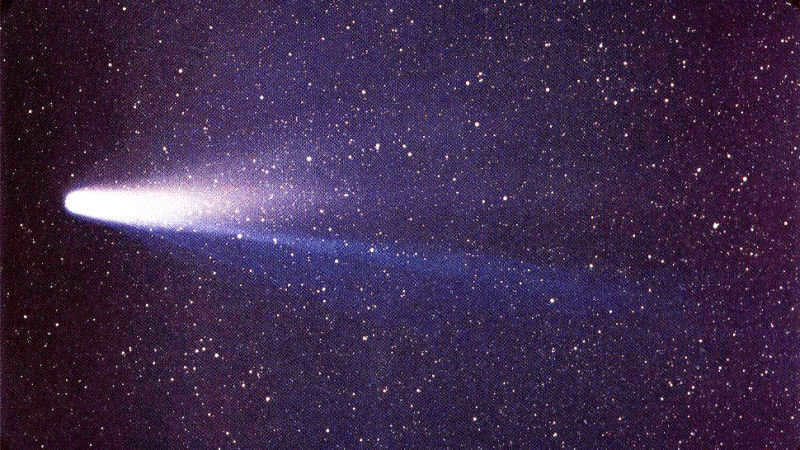
The movement of celestial bodies in space
By understanding that an orbit is a possible path for celestial bodies, scientists have been able to explain the paths taken by various celestial bodies. Comets, satellites, planets, and stars all follow elongated trajectories. For instance, there are comets with highly elongated paths that may intersect with a planet’s orbit. If the planet and comet align at a certain point in their motion, a collision may occur or the gravitational force may alter the comet’s orbit, causing it to become “captured” by the planet. Scientists believe that this is how comet rings around certain planets and satellites were formed.
The path of the Sun
The Sun’s journey through the cosmos is traced along its Galactic path. In relation to the celestial bodies, our star travels at a velocity of 19 km/s towards the Hercules constellation. It is hypothesized that the Sun completes a full orbit around the center of the Galaxy every 230 million years. The orbital movement of the Sun is intricate, as its trajectory is constantly influenced by the gravitational forces of massive cosmic entities, other stars, and interstellar gas.
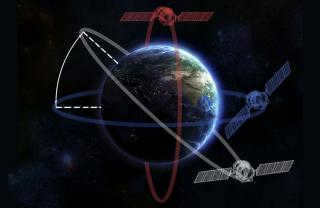
The Earth possesses a gravitational field as do other celestial bodies, and it is surrounded by various orbits that can accommodate objects and bodies of varying sizes. Among these orbits, the most prominent ones include the Moon’s orbit and the International Space Station’s orbit. The Moon follows its own distinct orbit, while the ISS orbits in a low Earth orbit. These orbits differ from each other in terms of their distance from the Earth, their spatial orientation relative to the planet, and their rotational direction.
Paths Traveled by Man-Made Satellites Circling the Earth
As of now, there exists a multitude of entities in close proximity to Earth that have been generated by human endeavors. These entities primarily consist of man-made satellites that serve communication purposes, although there is also a significant amount of space debris. Among the most renowned man-made satellites orbiting Earth is the International Space Station.
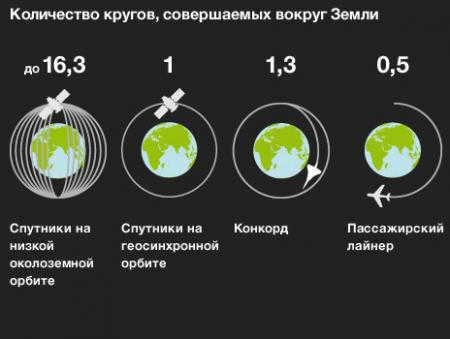
There are three primary types of spacecraft orbits: equatorial (geostationary), polar, and inclined. The equatorial orbit is located entirely within the plane of the equatorial circle, while the polar orbit is perpendicular to it. The inclined orbit falls in between these two.
Geosynchronous orbit
This trajectory gets its name because the object traveling along it moves at the same speed as the Earth’s rotation period. The geostationary orbit is a specific type of geosynchronous orbit that lies in the same plane as the Earth’s equator.
When the satellite has an inclination that is not zero and an eccentricity that is zero, it appears to trace a figure-eight shape in the sky during the course of a day when observed from Earth.
The American Syncom-2, launched in 1963, was the pioneering satellite to be placed in geosynchronous orbit. Today, in certain instances, satellites are positioned in geosynchronous orbit due to the inability of the launch vehicle to place them into geostationary orbit.
Geostationary orbit
This particular trajectory is referred to as such because, despite its continuous movement, an object on it remains motionless in relation to the Earth’s surface. The location where the object is situated is known as the stationary point.
Satellites situated in this orbit are often utilized for satellite television transmission, as the stationary nature allows for the antenna to be pointed at it once and maintain a stable connection for an extended period of time.
The height of the satellites in the geostationary orbit is approximately 35,786 kilometers. As they are all positioned directly above the equator, only the meridian is designated to indicate their location, such as 180.0˚E Intelsat 18 or 172.0˚E Eutelsat 172A.
The orbit has an estimated radius of around 42,164 km, a circumference of approximately 265,000 km, and an orbital speed of about 3.07 km/s.
Orbiting in a highly elliptical path
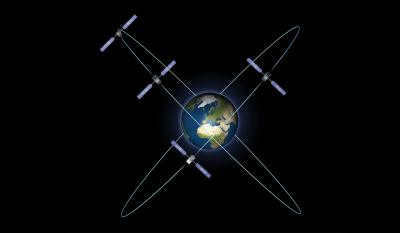
An orbit with a high ellipticity is a path where the altitude at the closest point to Earth is much lower than at the farthest point. There are several advantages to launching satellites into this type of orbit. For instance, a single high elliptical orbit system can cover the entire expanse of Russia or a group of similarly-sized countries. Moreover, HEO systems in regions with high latitudes offer more functionality compared to geostationary satellites. Additionally, the cost of launching a satellite into a high elliptical orbit is roughly 1.8 times cheaper.
Notable examples of systems powered by high elliptical orbits include:
- Space observatories launched by NASA and ESA.
- Sirius XM Radio Satellite Radio.
- Meridian, -Z and -ZK, Molniya-1T satellite communications.
- GPS satellite correction system.
Low Earth orbit
can be restated as “The region of space around the Earth where satellites and other objects orbit at relatively low altitudes.”
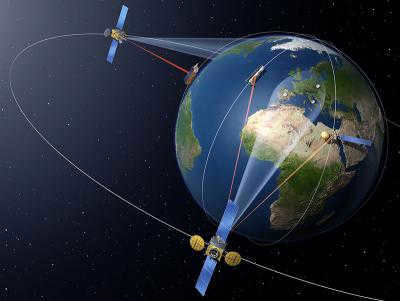
This particular orbit is considered to be one of the closest to Earth and can have a range of altitudes between 160 and 2000 km. The orbital period for this type of orbit can vary between 88 and 127 minutes, depending on different factors. The only time that manned spacecraft have successfully reached and surpassed this orbit was during the Apollo program when American astronauts landed on the moon.
A majority of the artificial satellites that are currently in use or have been used in the past have operated within the low Earth orbit. As a result, this region now contains a significant amount of space debris. The optimal velocity for satellites in this orbit is typically around 7.8 km/s.
- The International Space Station is located 400 km above the Earth.
- There are various telecommunications satellites belonging to different systems and networks.
- There are also reconnaissance and probe satellites in orbit.
The abundance of space debris in space is currently the main problem facing the entire space industry. The situation is such that the likelihood of objects colliding in low Earth orbit (LEO) is increasing. This, in turn, leads to more destruction and the creation of additional fragments and parts in orbit. Pessimistic predictions suggest that the Domino Principle could potentially prevent humanity from fully exploring and utilizing space.





